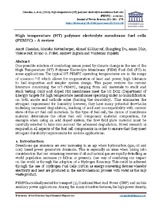| dc.contributor.author | Chandan A, Hattenberger M,Pollet BG and 6 other | |
| dc.contributor.author | Chandan, Amrit | |
| dc.contributor.author | Hattenberger, Mariska | |
| dc.contributor.author | El-kharouf, Ahmad | |
| dc.contributor.author | Du, Shangfeng | |
| dc.contributor.author | Dhir, Aman | |
| dc.contributor.author | Self, Valerie | |
| dc.contributor.author | Pollet, Bruno G. | |
| dc.contributor.author | Ingram, Andrew | |
| dc.contributor.author | Bujalski, Waldemar | |
| dc.date.accessioned | 2018-01-09T09:00:48Z | |
| dc.date.available | 2018-01-09T09:00:48Z | |
| dc.date.issued | 2013 | |
| dc.identifier.citation | Chandan, A. et al. (2013). High temperature (HT) polymer electrolyte membrane fuel cells (PEMFC) – A review. Journal of Power Sources, 231: 261 - 278 | en_US |
| dc.identifier.issn | 0378-7753 | |
| dc.identifier.uri | http://dx.doi.org/10.1016/j.jpowsour.2012.11.126 | |
| dc.identifier.uri | http://hdl.handle.net/10566/3366 | |
| dc.description.abstract | One possible solution of combating issues posed by climate change is the use of the High Temperature (HT) Polymer Electrolyte Membrane (PEM) Fuel Cell (FC) in some applications. The typical HT-PEMFC operating temperatures are in the range of 100e200 o C which allows for co-generation of heat and power, high tolerance to fuel impurities and simpler system design. This paper reviews the current literature concerning the HT-PEMFC, ranging from cell materials to stack and stack testing. Only acid doped PBI membranes meet the US DOE (Department of Energy) targets for high temperature membranes operating under no humidification on both anode and cathode sides (barring the durability). This eliminates the stringent requirement for humidity however, they have many potential drawbacks including increased degradation, leaching of acid and incompatibility with current state-of-the-art fuel cell materials. In this type of fuel cell, the choice of membrane material determines the other fuel cell component material composition, for example when using an acid doped system, the flow field plate material must be carefully selected to take into account the advanced degradation. Novel research is required in all aspects of the fuel cell components in order to ensure that they meet stringent durability requirements for mobile applications. | en_US |
| dc.language.iso | en | en_US |
| dc.publisher | Elsevier | en_US |
| dc.rights | This is the author-version of the article published online at: http://dx.doi.org/10.1016/j.jpowsour.2012.11.126 | |
| dc.subject | Fuel cell | en_US |
| dc.subject | Intermediate/high temperature | en_US |
| dc.subject | PEM Stack | en_US |
| dc.subject | Bipolar plate | en_US |
| dc.subject | Catalyst layer | en_US |
| dc.subject | Gas diffusion layer | en_US |
| dc.title | High temperature (HT) polymer electrolyte membrande fuel cells (PEMFC) - A review | en_US |
| dc.type | Article | en_US |
| dc.privacy.showsubmitter | FALSE | |
| dc.status.ispeerreviewed | TRUE | |
| dc.description.accreditation | Web of Science | |

